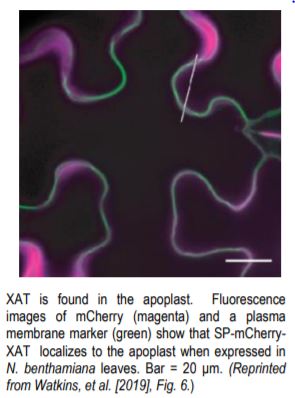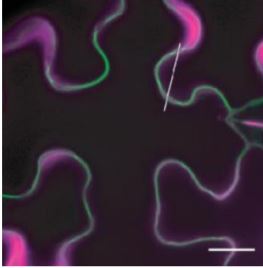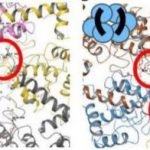Keeping an Eye on Lutein Stability
Carotenoid pigments not only produce the vibrant yellows and oranges of flowers, fruits, and autumn leaves, but they also are important in both plant and human health. They act both as accessory pigments in photosynthetic light harvesting and as photoprotectants that absorb excess energy during photosynthesis. β-carotene is a well-known dietary carotenoid that, when converted into retinal, is important for human vision (Concepcion et al., 2018).
Lutein (from the Latin “luteus” for yellow) is a carotenoid found in the central area of the retina known as the macula, an area important for color vision (Johnson, 2014). Lutein alleviates macular degeneration and improves vision, perhaps by absorbing excess blue and ultraviolet light that enters the eye. It is the primary carotenoid in mature wheat grains. In diets poor in fresh fruits and vegetable, cereal grains can be the primary source of lutein. Esterification of lutein with fatty acids, such as linoleic or palmitic acid, stabilizes lutein in wheat grains. Despite much recent progress in carotenoid biochemistry and metabolism (Nisar, 2015; Zhai, et al., 2016), the genetic and enzymatic mechanisms responsible for lutein esterification have remained elusive.
Using both a wheat cultivar that does not produce lutein esters and a substitution line in which its chromosome 7A was replaced by chromosome 7D from a line that accumulates lutein esters, Watkins et al., (2019) showed that this chromosome confers the ability to esterify lutein in wheat grains. On this chromosome, they then identified and isolated Xat (encoding a xanthophyll acyltransferase) and showed that XAT was necessary and sufficient for lutein esterification in wheat grains. Six independent TILLING lines (targeted induced local lesions in genomes) mutated in Xat were unable to produce lutein esters.
 To verify its lutein esterification activity in vitro, recombinant XAT was produced in Escherichia coli and used in assays with lipids from a high-lutein line lacking both XAT and lutein esters. Addition of recombinant XAT resulted in production of several types of lutein esters. Because wheat XAT contains the conserved GDSL (Gly-Asp-Ser-Leu) motif found in a number of esterase/lipases, and the Ser in this motif (Ser-37) has been shown to be important in catalysis, the authors mutated the Ser to Ala. Lutein esterification was abolished, confirming a vital catalytic role for Ser-37.
To verify its lutein esterification activity in vitro, recombinant XAT was produced in Escherichia coli and used in assays with lipids from a high-lutein line lacking both XAT and lutein esters. Addition of recombinant XAT resulted in production of several types of lutein esters. Because wheat XAT contains the conserved GDSL (Gly-Asp-Ser-Leu) motif found in a number of esterase/lipases, and the Ser in this motif (Ser-37) has been shown to be important in catalysis, the authors mutated the Ser to Ala. Lutein esterification was abolished, confirming a vital catalytic role for Ser-37.
Analysis of the XAT esterification reaction in vitro with a variety of acyl donors and lutein as acceptor showed triacylglycerides to be the preferred donor. More detailed analysis allowed the authors to determine the Km for lutein to be approximately 60 μM, and revealed that XAT has both esterase and lipase activity.
In situ hybridization with labeled riboprobes showed that Xat transcripts were abundant in endosperm and aleurone. To determine the subcellular localization of XAT, the authors produced fusions of the predicted signal peptide (SP) of XAT with mCherry with or without the XAT coding sequence and expressed the constructs in Nicotiana benthamiana leaves. Surprisingly, because carotenoids are found primarily in plastids, XAT localized to the apoplastic region just outside the plasma membranes of adjacent cells (see figure).
The authors propose that XAT and its carotenoid substrates (such as lutein) are separated spatially during grain maturation. During grain maturation, programmed cell death allows enzyme and substrate to react, stabilizing lutein in the mature grain. To further investigate lutein esterification in vivo, they use rice embryonic callus as a model system, with an eye toward improving the nutritional value of cereals. For example, introgression of Xat from bread wheat into durum wheat to stabilize its lutein could provide us with healthier, more attractive, and higher quality pasta, simultaneously satisfying both nutritional and industrial goals.
Gregory Bertoni
Science Editor
ORCID ID: 0000-0001-7977-3724
REFERENCES
Concepcion, M.R. et al. (2018). A global perspective on carotenoids: Metabolism, biotechnology, and benefits for nutrition and health. Prog. Lipid Res. 70: 62–93.
Johnson, E.J. (2014). Role of lutein and zeaxanthin in visual and cognitive function throughout the lifespan. Nutr. Rev. 72: 605–612.
Nisar, N., Li, L., Lu, S., Khin, N.C., and Pogson, B.J. (2015). Carotenoid metabolism in plants. Mol. Plant 8: 68–82.
Watkins, J.L., et al. (2019). A GDSL esterase/lipase catalyzes the esterification of lutein in bread wheat. Plant Cell. Published Dec. 2019. DOI: https://doi.org/10.1105/tpc.19.00272.
Zhai, S., Xia, X., and He, Z. (2016). Carotenoids in staple cereals: metabolism, regulation, and genetic manipulation. Front. Plant Sci. 7: 1–13.




